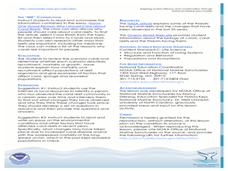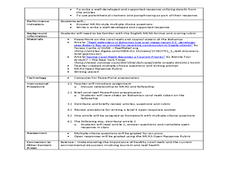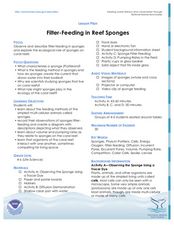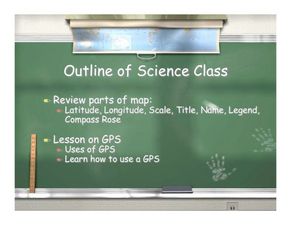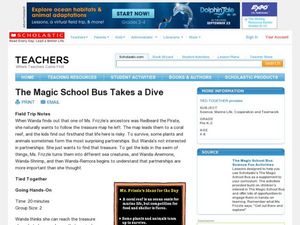Curated OER
The Changing Coral Reef
Students record changes in the composition of a coral reef. In this Coral Reef lesson, students recognize the needs of Coral Reef species to survive. Students chart changes in population over time. Students write an essay...
Curated OER
Keeping Watch on Coral Reefs
Students investigate the dangers Coral Reefs face by investigating satellite images. In this environmental protection instructional activity, students utilize the Internet to discover the types of satellites and sensors used to...
Curated OER
How Diverse is That?
Compare various types of biological diversity in a coral reef and calculate a numeric indicator that describes the diversity found in coral communities. Your class can work in groups to look at the abundance and distribution data of...
Curated OER
Design a Reef!
Students explore coral reef ecosystems. In this ecosystems science lesson, students research coral reef ecosystems to determine the major functions the participating organisms must perform. Students construct a miniature...
Curated OER
Bahamian Coral Reef Development
Young scholars study tourism and conservation. In this coral development lesson students view a PowerPoint presentation and write a report.
Curated OER
Coral Reef Ecology
Students explore coral life cycles. In this coral ecosystems lesson, students view videos explaining the life cycle of coral, including examples of sexual and asexual reproduction. Students read a related article cooperatively in groups,...
Curated OER
Sustainable Southern Belize: Coral Health Lesson Plan
Fifth graders investigate coral reefs and the dangers they face by labeling and drawing. In this oceanography lesson, 5th graders view a PowerPoint presentation of photographs of coral reefs in Belize. Students investigate...
Curated OER
Growing A Coral Skeleton
Students research the growth of coral. In this coral polyps lesson, students simulate the growth of coral by using available materials to grow crystals. Students record observations in a scientific journal.
Curated OER
Deep Gardens
Learners compare and contrast deep-sea coral reefs with shallow-water coral reefs. In this underwater ecology lesson, students describe three types of coral and explain why scientists are concerned about the future of deep-sea coral.
Curated OER
Introduction to Ocean Grazers
Students explore biology by creating a poster with classmates. In this oceanography instructional activity, students identify the importance of coral reefs to the ocean's ecology and examine a food web of ocean animals. Students define a...
Curated OER
Caution: Do No Bleach!
Students explore coral reef bleaching. In this coral reef lesson, students identify the benefits of coral reefs and the 3 major treats to coral reefs. Students research how to lessen the threats and discuss the actions that need to be...
Curated OER
Filter Feeding in Reef Sponges
Students investigate the role of sponges in our oceans. In this biology lesson plan, students create a diagram visualizing how sponges bring food into their bodies through a filtering process. Students discuss the connections...
Curated OER
Plant and Animal Cells
Students investigate parts of a cell. In this plant cell lesson, students determine the difference between plant and animal cells. Students discover that coral is an animal based on cell characteristics. Students create puppets to...
Curated OER
Do Not Bleach!
Students explore the importance of protecting the coral reefs. For this Oceanography lesson, student examine how coral reefs benefit humans, identify major threats to the reefs, and discuss actions to reduce these threats.
Curated OER
Learning Scientific Coral Terminology
Students explore properties of coral. In this scientific observation lesson, students investigate properties and characteristics of coral. Students write statements describing the coral using observation words.
Curated OER
Seals, Corals, and Dollars...
Students explore the interdependence of animals and their habitat. In this Hawaiian ecology lesson, students work in groups to research the necessity of preserving precious coral as a habitat for monk seals. Students prepare...
Curated OER
Bank On It! Environment
In this science worksheet, students complete a cloze activity about coral reefs. They select words from a word box to fill in the 15 blanks in the article. This worksheet could also be used for reading comprehension in a language arts...
Curated OER
Call to Arms: Robotic Analogues for Human Structures
Investigate deep sea discovery through the emerging technology being built. In this physical science lesson, students analyze the different types of motion available in the human arm. Students research educational websites...
Curated OER
Lesson on GPS
Students investigate global positioning systems. In this technology and mapping lesson, students view a PowerPoint presentation in which they identify the features of a GPS, state its uses, and follow steps to find a waypoint.
Curated OER
The Magic School Bus Takes a Dive
Students learn along with Ms. Frizzle's class. In this Magic School Bus lesson plan, students find out how partners can help run a race just as Wanda learns that survival on the coral reef often depends on cooperation.
Curated OER
Great Barrier Reef-Guarding Nemo
Students explore the Great Barrier Reef. In this environmental stewardship lesson, students conduct research regarding the Great Barrier Reef and examine methods to preserve the Reef. Students apply the RAFT method to prepare a final...
Curated OER
A Novel Study Unit for The Cay
Novelly written questions are perfect for a novel study guide unit on The Cay. The well-rounded resource contains an anticipation guide for scholars to complete before reading, a variety of questions per chapter of the book, and a post...
Curated OER
Build an Anchialine Pond
Students explore biology by conducting a nature experiment. In this pond examination lesson, students utilize recycled materials, play-doh and water to recreate a pond and its inhabitants. Students identify the different elements within...
Curated OER
Ecosystem Interactions Web
Students pick an ecosystem (forest, desert, coral reef, open ocean, grassland, mountain, savanna, etc.) and design an interaction web for their chosen ecosystem. Each group shares their ecosystem's web of life with the class.
